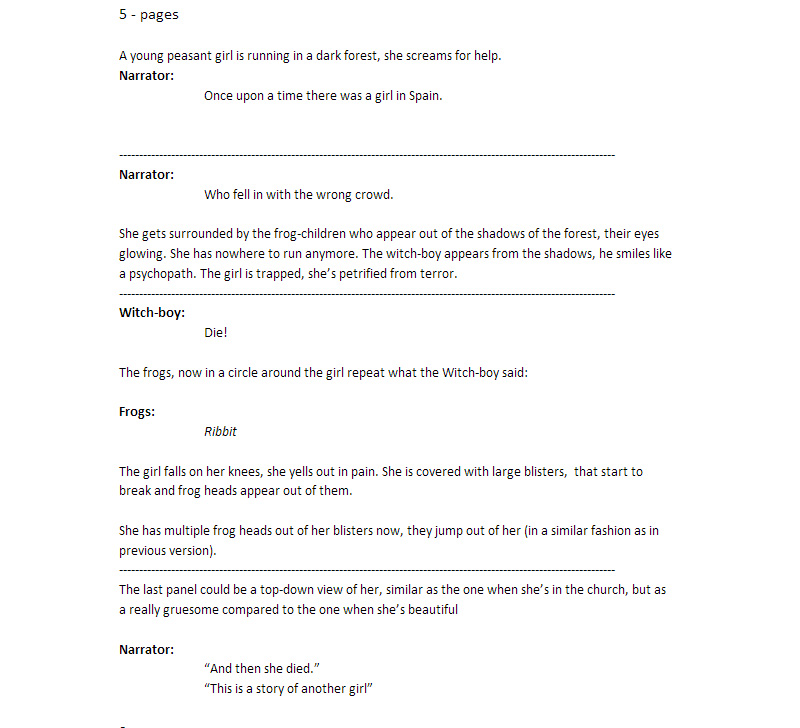
This post will go through the steps of writing a Run Freak Run comic page; it will cover how we start, how we work together and how I make the script as useful as possible for Kaija. In later blog posts Kaija or me will go through the others steps of our pipeline. This article is for all of you who are interested in how Run Freak Run is created and how it moves from prose to drawings.
Writing a page, the first step in our pipeline is also the fastest when compared to the labor intensive tasks like drawing and inking. And for the sake of this article, we’re assuming that you have all the world building and concepts at least somewhat figured out.
Everything I write, I start it with a loose bullet point outline. Let me give you an example for the first 5 pages in the first RFR chapter.
– Narrator say: Once upon a time in Spain, there was a girl
– Girls runs in dark forest.
– She’s scared.
– A monster follows her.
– She falls.
– The monster makes a spell.
– Frogs start coming out of the girls body, with exploding power.
– She dies.
– Narrator says: This a story about another girl.
– Next day, beautiful countryside, Inquisitor Two and Alonso are riding to town.
I like writing in bullet points; it’s easy, stress free and it lets me keep track of the big picture while also being great for fast progress. Every now and then I put a snippet of dialogue or description to the bullet points, just as an indication for a dialogue and what’s the main point for it. I’ve made the mistake of going to too detailed way too early, and got caught in trying to make sense of all the insignificant problems that shouldn’t matter yet. Now, I just cover as much ground as possible first and fix all my mistakes later. I only stop to ask myself what I’m promising with the story and how will I resolve them later.
Next step is to write my notes as prose. I’m still going fast and ignoring all grammar and format rules. I’ve noticed that being mindful of my writing kills my momentum. As long as it’s understandable, I go forward and start putting more thought and descriptions into the locations and dialogue, making sure that every character sounds different on paper. It doesn’t matter so much what they say, but how Kaija perceives their personality.
At this point, I’ll also attach reference pictures to help communicate my ideas for locations and characters. Kaija can use them as a starting point for creating her own reference library for the chapter.
When both me and Kaija feel confident about where the major plot and dialogue are going, I change the text into a format where it becomes easy to read for Kaija’s thumbnailing and drawing stages.

I won’t touch the script again until Kaija comes back with the her thumbnails. At that point we review the story and dialogue and see if it needs any major changes. As long as it makes sense, we go forward and I won’t touch the dialogue or story before lettering and editing phase.
Every creative team works differently and the process changes depending on how it is made. Most publishers and editors only deal with the writer, whose script they review, revise and approve, until it goes to the artist and letterer, never to be seen by the writer again. In these cases the writer usually breaks the comic, not only into pages, but also into panels and gives elaborate descriptions for the artist to work with. It’s a good and efficient workflow for an industry that has tight deadlines, but it doesn’t really allow happy mistakes. Of course there’s exceptions, but in general, most of the comic scripts I’ve seen have panel-by-panel breakdowns.
Since Run Freak Run a self-published webcomic, we can do whatever we want, in whatever order we want. And it seems that is how most webcomics work as well, without any formal guidelines, figuring themselves out as they onward.
For additional studying, you should get your hands on scripts from different authors, analyze them, learn the pipeline and break the magic behind them.
One of my favourite comic book writers, Brian Wood has some of his scripts online for you to study. The scripts he has online change depending of the publisher and artist he works with and I think they’re great learning material for anyone:
http://www.comicbookscriptarchive.com/archive/scripts/brian-wood-script-pack/
How to write a webcomic summary:
– Don’t stop for your errors, ride that momentum!
– Start by bullet point plot lining.
– Ask yourself what promises you make and how you resolve them.
– Then write it in prose, still ignoring your mistakes.
– Then format it into a script and fix grammar.
– Edit and revise at the appropriate time (lettering and editing)
– Study and find out what works for you. :)
Tune up for more steps on how we make the comic!
– How to make a web comic: thumbnailing Run Freak Run
See you laters, alligators – Silver
